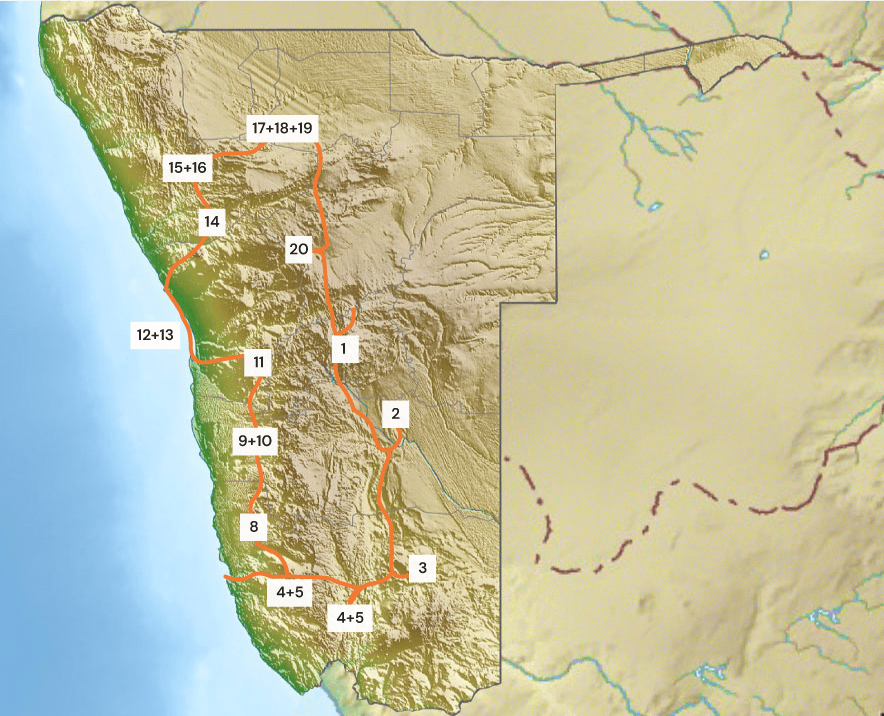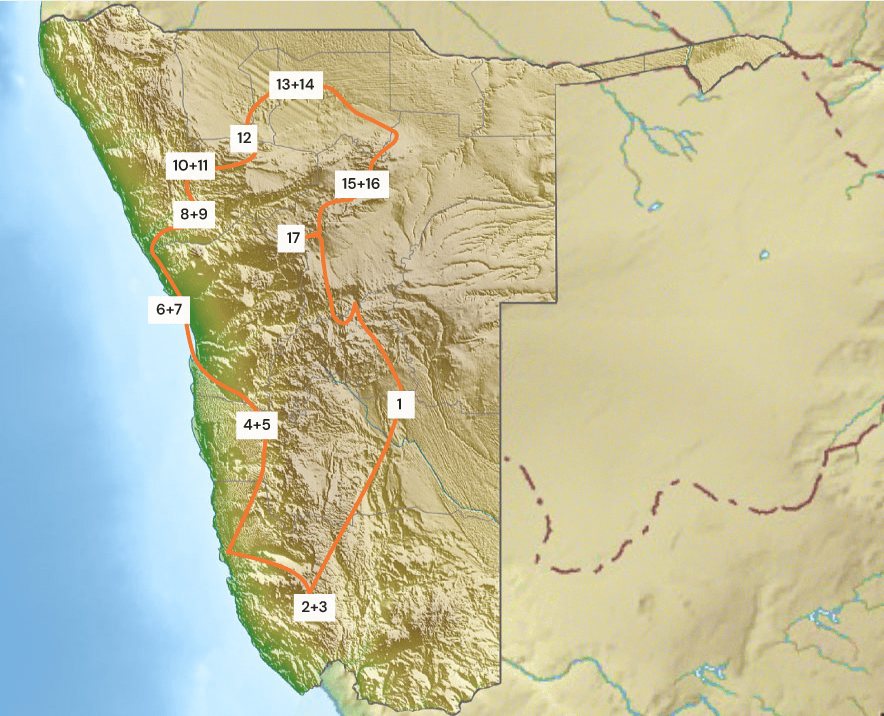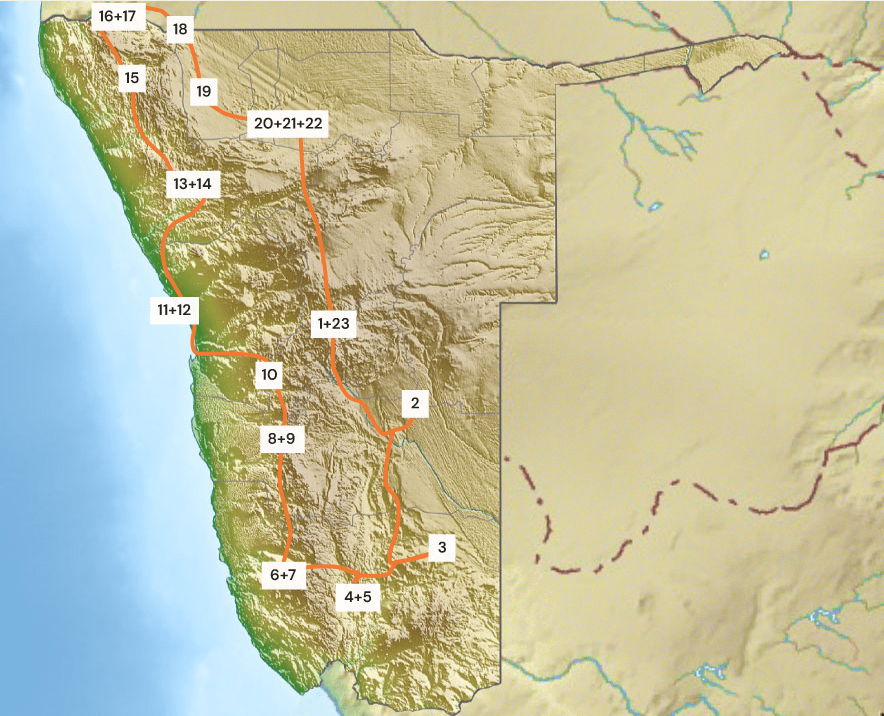
Namibia Private Fly-In Safari
Highlights: Windhoek, Kalahari, Fish River Canyon, NamibRand Reserve / Namib Desert, Kunene, wonderful contrasts, desert-adapted animals in the wild, and changing landscapes.
INFORMATION
Based on 2 persons in a double room (four-seater, small aircraft Cessna 210)
From NAD: 434,140.00
For two married couples (four people) per person.
From: NAD 108,535.00
Included
12 x nights accommodation
6 x lunch
13 days private charter safari (Cessna 210 airplane)
1 x Namibia manual
Other services included at some lodges, e.g. local drinks and laundry service
12 x breakfast
12 x dinner
Detailed travel documents
Activities according to the program on days 6, 7, 8, 9, 10, 11, 12
Tour Program

BB= Overnight stay | Breakfast
DBB= Dinner | Overnight stay | Breakfast
FB= Lunch or lunch packages | Dinner | Overnight stay | Breakfast and activities
Day
1
Overnight: Lodge in the Kalahari Desert (Dinner, Bed & Breakfast)
Arrival in Windhoek at the Hosea Kutako International Airport.
Your pilot will meet you in the Arrivals Hall and escort you through your private charter plane (Cessna 210 or similar). Kindly
note that 10kg luggage (packed in soft bags) is allowed per person for this fly-in safari.
Your private charter fly-in safari can now commence. You fly to the small town of Mariental (flight time is approx. 01:05 hours).
A representative of the lodge will welcome you at Mariental Airport. Subsequent vehicle transfer to the lodge, (approx. 45
minutes) which is situated in the red dunes of the Kalahari Desert. You can spend the afternoon at leisure, or opt to book an
afternoon sundowner tour into the Kalahari directly with the lodge (optional). This activity is offered in an open and comfortable
off-road vehicle. The guide will share his knowledge and passion for this area. This is a tour to get to know the Kalahari with its
unforgettable landscapes, fauna and flora. Alternatively, you can also explore the Kalahari on foot, a map for walking trails is
available at the reception.
Day
2
Overnight: Lodge in the Kalahari Desert (Dinner, Bed & Breakfast)
Today you can opt to partake in the variety of activities on offer from the lodge, or choose to relax in the magnificent Kalahari
environment. The Kalahari (also Kalagadi) is a thorn bush savannah, partially also a dry savannah, but is sometimes referred to
as a desert because of the prevailing red sands. Oryx, springbok and other smaller mammals avail themselves for wonderful
animal motifs, in the backdrop of the red dune sands. Optionally we recommend that you partake in a cheetah excursion today.
Day
3
Overnight: Lodge in the Kalahari Desert (Dinner, Bed & Breakfast)
This morning you can spend the time at leisure, or optionally you can go on a guided bushman tour with the lodge. Get to know
this ancient tribe, their customs and traditions that they still keep today. Other activities include Cheetah Excursions, Morning,
Afternoon or Night Drives, Horseback Safari and many more. Alternatively, you can enjoy the day at leisure in the calm and
peaceful Kalahari environment and perhaps join a Star Safari from the Observatory to see the clear night sky (weather permitting).
Day
4
Overnight: Lodge on the rim of the Fish River Canyon (Dinner, Bed & Breakfast)
You check out from the lodge at around 10:00 am today, and thereafter you will be transferred back to Mariental Airport, and
the flight circuit continues to the Fish River Canyon. After arrival and transfer from the airstrip to the lodge you can spend the
remaining afternoon at leisure, or chose to go on a sundowner tour with the lodge, or take a walk along the rim of the Canyon.
At 650 kilometres the Fish River is the longest river in Namibia. A very, very long time ago, the Fish River left the Naukluft
mountains attempting to find its way to the Orange River, in the south of the country. But mountains blocked its flow and so
the largest canyon in Africa was formed. It took 120 million years of meticulous work for the creation of the Fish River Canyon.
It is a vast labyrinth, in which temperatures of 50 degrees in the summer months are considered quite normal.
Day
5
Overnight: Lodge on the rim of the Fish River Canyon (Dinner, Bed & Breakfast)
Today we recommend that you join a lodge tour which will take you deep into the Fish River Canyon. This is a day activity, and
can be booked directly with the lodge. The vehicle winds its way through the different layers of the massive canyon. 650 million
years ago you would have been standing at the bottom of a lake, here. If you look down to a depth of 550m, you get the feeling
that you are standing on the edge of eternity. Few places in the world reveal the layers of the earth as dramatically as the Fish
River Canyon. In the afternoon you return to the lodge for another overnight.
Day
6
Overnight: Lodge in the Namib Rand Reserve (Fully Inclusive)
Today, after a leisurely breakfast, you will take off and fly to the coastal town of Lüderitz, here the plane will refuel. Thereafter
onward flight to the NamibRand Reserve, where you will spend the next four nights. All meals are included here, and you can
choose to partake in a variety of activities during the next days. Activities to choose from are Morning or Afternoon nature drives,
Sundowner or Sunrise drives, Full day scenic safari, village tour, fat E-Biking, and an Antares Tour (naked eye star safari), these
are just a few to mention.
Note however, this lodge does not offer visits to the Sossusvlei sites, as it is too far to reach this area.
Day
7
Overnight: Lodge in the Namib Rand Reserve (Fully Inclusive)
During the next three days we recommend that you partake in as many activities as you can. The unique NamibRand Reserve
is a nature lovers ideal place. Virtually all the facets of the Namib Desert are represented on the Reserve – sand and gravel
plains and stretches of savanna alternate with mountain ranges, inselbergs and vegetated dune belts. We recommend
that you choose either a Morning or Afternoon nature drive today, to enjoy the splendour of the Reserve.
Day
8
Overnight: Lodge in the Namib Rand Reserve (Fully Inclusive)
Enjoy another day filled with activities on offer from the lodge. How about exploring the environment on a Fat Bike Tour during
the course of the morning, following the winding roads through the reserve over hills, sand dunes and vast plains. You
can cycle to a little desert picnic spot or just down to the village. In the afternoon join a sundowner drive to round of the day
with a splendid sunset in nature. At a scenic point to bid farewell to another magical day. Sometimes you meet up with other
guests at one of the sundowner decks and at other times it’ll be just you on a sand dune.
Day
9
Overnight: Lodge in the Namib Rand Reserve (Fully Inclusive)
Today we recommend that you join a full day scenic safari. Breathe and take in the crazy array of colours to be found in the
vast plains, mountains and sand dunes of the NamibRand reserve. You will also learn about small and large desert dwellers and
their quest for survival and you’ll discover a diverse flora, ranging from resilient beauty to hardened survivor – not to mention the
reserves fascinating geology.
Alternatively, you can choose to just relax on the last day at the lodge. The NamibRand Nature Reserve in the Namib Desert is
one of the quietest places on earth. It’s a big claim to make but it is true. Our daily lives are often filled with noise and activity,
but here on the reserve, the lodge will facilitate your escape from this.
Day
10
Overnight: Lodge on the banks of the Kunene River (Fully inclusive)
The fly-in safari now takes you further north over the endless landscapes of the Namib desert via coastal town of Swakopmund
and onwards over the Skeleton Coast, up to Namibia’s northern border. En Route you will see Namibia’s spectacular and vastly
varying landscapes from the air. Many different shapes of dunes, old mining ghost towns, as well as eerie shipwrecks that are
dotting the shores of the Skeleton Coast here and there.
After arrival at the airstrip a scenic transfer takes you to the lodge which is situated on the banks of the Kunene River. This is an
extraordinary desert retreat, straddling an astonishingly contrasting landscape, in one of the most untouched and secluded areas
in Southern Africa. You can enjoy three overnights here which are all on a fully inclusive basis.
Day
11
Overnight: Lodge on the banks of the Kunene River (Fully inclusive)
Today you can enjoy one of the many activities on offer at this unique lodge. The lodge offers a variety of activities including
nature drives, guided nature walks, boating, guided quad bike excursions, birding, stargazing with a laser pointer and a cultural
visit to a nearby working Himba village.
This are is area is a retreat where you can truly disconnect and unwind to the sound of rushing water, and beyond, to the
powerful silence of the desert. We recommend a nature drive today where you can discover the diverse and contrasting
landscapes, from dunes to fascinating geological features. Surprisingly a broad spectrum of amazing wildlife has adapted to this
environment. You can expect to see desert adapted Oryx, springbok, Hartmann’s mountain zebras, Nile crocodiles and myriad
birds on the banks of the Kunene river.
Day
12
Overnight: Lodge on the banks of the Kunene River (Fully inclusive)
We recommend that you take a unique opportunity to explore the desert up close on a guided quad bike tour during the morning.
This excursion is conducted with the utmost care along specifically allocated pathways, so as to tread lightly on the dunes and
preserve the unique and delicate habitat of this landscape.
During the afternoon a boating excursion on the Kunene River is a recommendation. Expect to see an abundance of water bird
species as well as many Nile crocodiles. Optionally you can also visit a nearby Himba village and learn about the customs and
traditions of this ancient nomadic tribe.
Day
13
Return to Germany
Today after breakfast and check out, you will be returning to the airstrip. From here your flight continues to Ondangwa for a
refuelling stop and thereafter your flight continues over the spectacular central Namibian highland landscapes back to the capital
Windhoek, to the Hosea Kutako international airport.
Here you bid your pilot farewell before checking in for your return flight home in the late afternoon.








